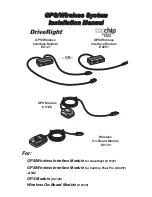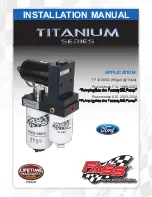
PRIMING IF THE ENGINE HAS RUN
OUT OF FUEL — DIESEL ENGINE
WARNING!
Do not open the high pressure fuel system with the
engine running. Engine operation causes high fuel
pressure. High pressure fuel spray can cause serious
injury or death.
1. Add a substantial amount of fuel to the tank,
approximately 2 to 5 gal (8L to 19L).
2. Three priming cycles must be completed. Turn igni-
tion to the RUN position and wait approximately
30 seconds. This will activate the in tank fuel pump.
Turn the ignition switch to the off position, and leave
off for at least 30 seconds. Repeat this procedure
three times before cranking the engine.
3. Start the engine using the “Normal Starting” proce-
dure. Refer to “Starting Procedures” in “Starting and
Operating” for further information.
4. Once the engine starts, allow the engine to idle for a
minimum of 30 seconds.
CAUTION!
Do not engage the starter motor for more than
15 seconds at a time. Allow two minutes between the
cranking intervals.
NOTE:
The engine may run rough until the air is forced from all
the fuel lines.
WARNING!
Do not use alcohol or gasoline as a fuel blending
agent. They can be unstable under certain conditions
and be hazardous or explosive when mixed with die-
sel fuel.
CAUTION!
Due to lack of lubricants in alcohol or gasoline, the
use of these fuels can cause damage to the fuel
system.
NOTE:
•
A maximum blend of 5% biodiesel, meeting ASTM
specification D-975 may be used with your
Cummins® diesel engine. (Chassis Cab models not
configured with B20 capability.)
•
A maximum blend of 20% biodiesel, meeting ASTM
specification D-7467 may be used with your
Cummins® diesel engine. (Pickup models and Chas-
sis Cab models configured with B20 capability.)
•
Use of biodiesel mixture in excess of 20% can nega-
tively impact the fuel filter's ability to separate water
from the fuel, resulting in high pressure fuel system
corrosion or damage.
•
Ethanol blends are not recommended or approved
for use with your Cummins® diesel engine.
•
In addition, commercially available fuel additives are
not necessary for the proper operation of your
Cummins® diesel engine.
INTERVENTION REGENERATION
STRATEGY — MESSAGE PROCESS
FLOW
The Cummins® diesel engine meets all Environmental
Protection Agency (EPA) Heavy Duty Diesel Engine Emis-
sions Standards, resulting in one of the lowest emitting
diesel engines ever produced.
To achieve these emissions standards, your vehicle is
equipped with a state-of-the-art engine and exhaust
system. The engine and exhaust after-treatment system
work together to achieve the EPA Heavy Duty Diesel
Engine Emissions Standards. These systems are seam-
lessly integrated into your vehicle and managed by the
Cummins® Powertrain Control Module (PCM). The PCM
manages engine combustion to allow the exhaust sys-
tem’s catalyst to trap and burn Particulate Matter (PM)
pollutants, with no input or interaction on your part.
If the engine is allowed to idle or the truck is driven on
low engine speed drive cycles for more than two hours,
the system will automatically enter an emissions oper-
ating mode that will increase the engine idle speed to
900 RPM (1050 RPM for Chassis Cab). While in this
mode, which is designed to help maintain the Diesel
Particulate Filter, the engine idle speed will return to
normal when the brake pedal is applied. A small
change in engine tone or a slight change in engine per-
formance while accelerating may also be noticeable at
speeds below 20 mph (32 km/h). This operating mode
may last for up to an hour of idle time, or around
20 minutes of driving time.
Additionally, your vehicle has the ability to alert you to
additional maintenance required on your truck or
engine.
Refer to “Instrument Cluster Display” in “Getting To
Know Your Instrument Panel” for further information.
SERVICING AND MAINTENANCE
301
7
















































